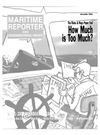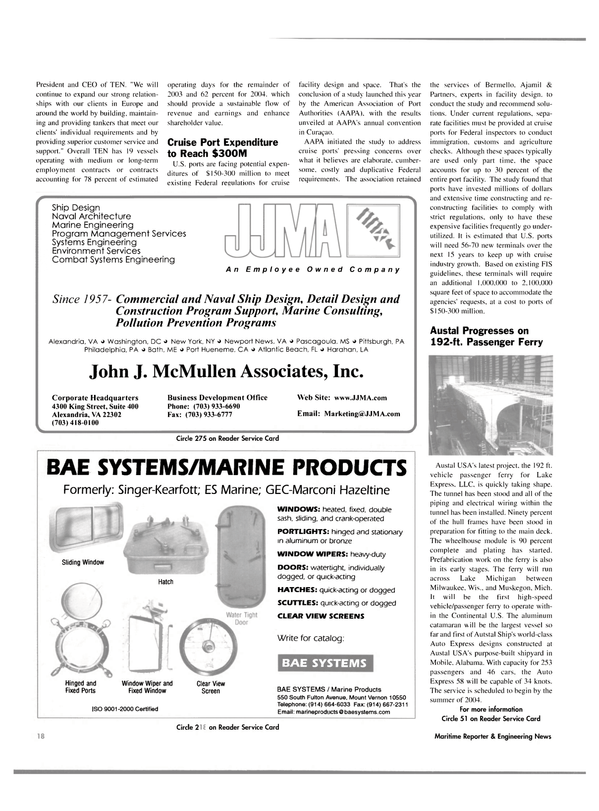
Cruise Port Expenditure to Reach $300M
U.S. ports are facing potential expenditures of SI50-300 million to meet existing Federal regulations for cruise facility design and space. That's the conclusion of a study launched this year by the American Association of Port Authorities (AAPA). with the results unveiled at AAPA's annual convention in Curasao.
AAPA initiated the study to address cruise ports' pressing concerns over what it believes are elaborate, cumbersome.
costly and duplicative Federal requirements. The association retained the services of Bermello, Ajamil & Partners, experts in facility design, to conduct the study and recommend solutions.
Under current regulations, separate facilities must be provided at cruise ports for Federal inspectors to conduct immigration, customs and agriculture checks. Although these spaces typically are used only part time, the space accounts for up to 30 percent of the entire port facility. The study found that ports have invested millions of dollars and extensive time constructing and reconstructing facilities to comply with strict regulations, only to have these expensive facilities frequently go underutilized.
It is estimated that U.S. ports will need 56-70 new terminals over the next 15 years to keep up with cruise industry growth. Based on existing FIS guidelines, these terminals will require an additional 1.000.000 to 2.100,000 square feet of space to accommodate the agencies' requests, at a cost to ports of $150-300 million.
Read Cruise Port Expenditure to Reach $300M in Pdf, Flash or Html5 edition of November 2003 Maritime Reporter
Other stories from November 2003 issue
Content
- EU Single-Hull Phase-Out Elicits I MO Scorn page: 10
- Costa Victoria in for a Facelift page: 11
- Sustainable Growth for Liner Shipping page: 11
- World's Biggest LNG Carrier Due in 2005 page: 12
- Shipbreaking in the Spotlight at ILO page: 14
- Signet Martime Inks Garrett Contract page: 16
- IZAR Enters Fast Ship Project page: 17
- TEN Signs Time Charter for Aframax Olympia page: 17
- Cruise Port Expenditure to Reach $300M page: 18
- At Sea with U.S. Maritime Security page: 20
- NY Navigation Channels: The Really Big Dig page: 25
- Kvichak Delivers for NY page: 28
- Vosta LMG signs U.S. contract for 18" Cutter Suction Dredge design page: 28
- Senesco Marine Christens New Drydock page: 29
- Workboat Annual 2003 • Great Boats of 2003 page: 30
- Natter Passes Command of Atlantic Fleet page: 41
- Introducing Lean Shipbuilding to U.S. Yards page: 42
- IBM PLM Offers New Shipbuilding Solutions page: 46
- Cosco Dalian Leads China Ship Repair Business page: 50
- China: Growing Influence in All Matters Maritime page: 52
- L'Orange at Marintec China 2003 page: 56
- Shiport China 2004: Set in Tune with the Shipbuilding Industry page: 57
- New Aluminum Marine Alloy Specification Developed page: 58
- InspecTech Launches Line of "Smart" Windows page: 62
- New CEO at Kvaerner Philadelphia page: 62
- Asheim Takes Helm of Hoegh Fleet page: 62
- New Potency in Electronic Control page: 68
- Research as the Building Block page: 70
- Knowledge Interchange page: 71
- Surface-Protection Symposium Set for Liibeck page: 78
- Xybernaut Gets Patent for Detecting Corrosion on Maritime Vessels page: 79
- LCS Hull Concept Tests Move Ahead page: 80
- Hypertherm Enters Laser Cutting Market page: 81
- E-Ship: The Paperless Trail page: 82
- Cradle Tweendecks Patent for Langh Ship page: 86
- Optimizing Feed Rates For Crosshead Diesels page: 88
- Benjamin Vickers: 175 Years & Counting page: 89
- Life Boats by Ernst Hatecke Make the Plunge page: 90
- Clean Seal Celebrates 25 Years page: 91
- Netherlands Vessel First With New Engine page: 92
- ONR To Evaluate SeaCoaster page: 92
- KMY Helps Breaks the Ice in Russia page: 97
- Astander Completes CSO Deep Pioneer Upgrade page: 97
- Rickmers Singapore Christened page: 97
- Transas Releases New Version of Engine Room Simulator page: 98
- Merseyside gets first UK escort tug simulator page: 98


